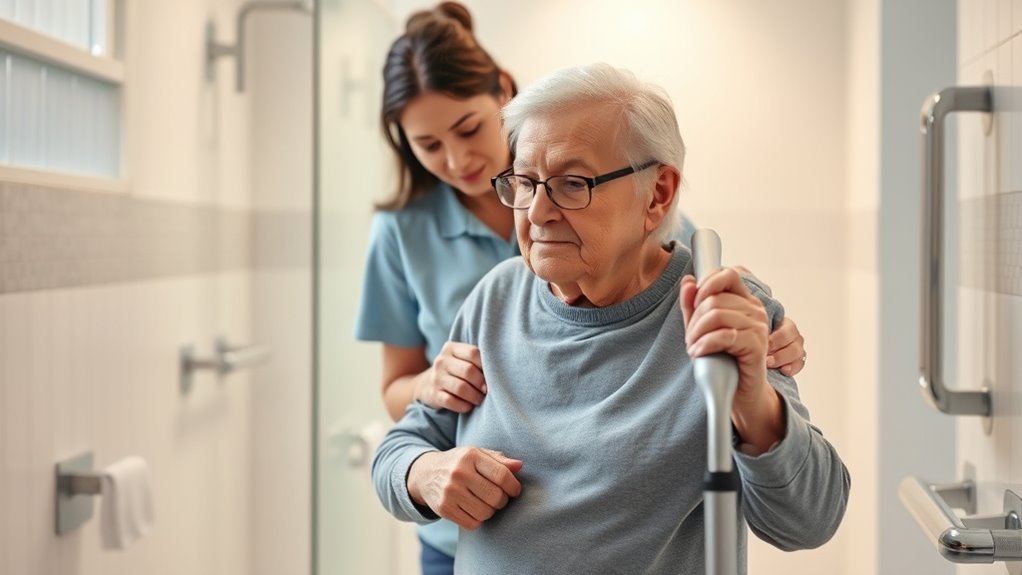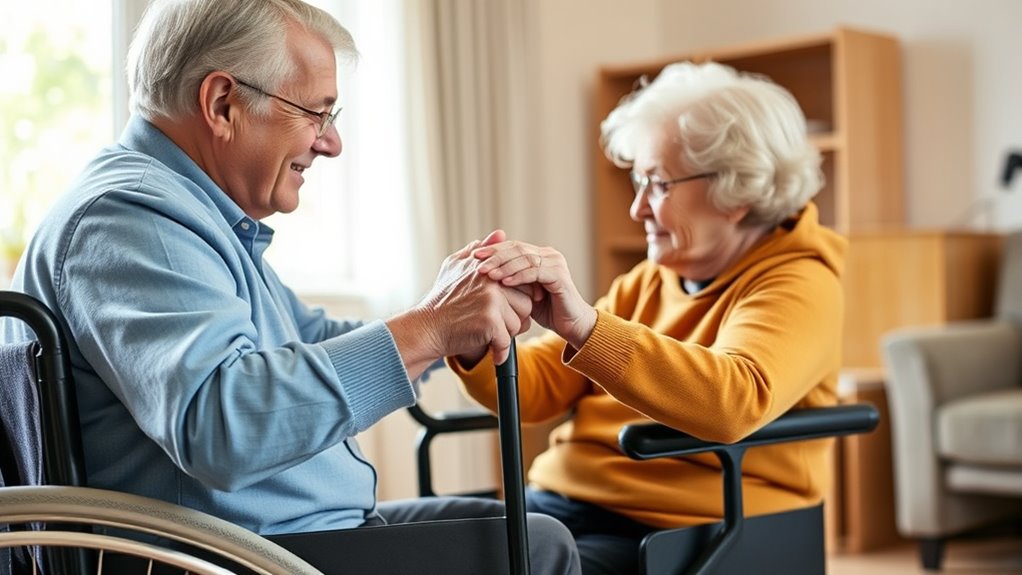To safely transfer a Parkinson’s patient with balance issues, clear the environment of clutter, ensure good lighting, and use slip-resistant floors. Use assistive devices suited to their needs and practice proper techniques like supporting their waist and guiding slowly. Maintain good body mechanics and clear communication to prevent falls. Watch for signs when professional help might be necessary. Keep exploring for detailed tips to make transfers safer and more confident.
Key Takeaways
- Prepare the environment by clearing clutter, securing slip-resistant floors, and ensuring good lighting for safe transfers.
- Select and properly use assistive devices tailored to the patient’s needs, with regular maintenance checks.
- Use proper body mechanics and clear communication to assist with sitting and standing safely.
- Encourage patients to hold supports and guide them slowly to prevent imbalance and falls.
- Seek professional help if transfers become difficult or if balance issues worsen, to prevent injury and improve safety.
Understanding the Challenges of Transfers in Parkinson’s Disease

Because Parkinson’s disease affects motor control and muscle strength, transferring from one position to another can be particularly challenging for patients. You may experience stiffness, slow movements, and tremors, making even simple transfers difficult. Your muscles might not respond quickly or smoothly, increasing the risk of imbalance or falls. As your coordination declines, tasks like sitting down, standing up, or shifting positions require extra effort and concentration. These challenges can lead to frustration and fear of falling, which may cause you to avoid necessary movements. Recognizing these difficulties and understanding the importance of proper transfer techniques can help you maintain your independence and reduce the risk of injury. Using proper transfer techniques and adaptive aids can significantly improve safety and confidence during these movements. Additionally, incorporating balance and strength exercises into your routine can help improve overall stability. Staying informed about AI-driven assistive technologies can also offer innovative solutions to support mobility and safety.
Preparing the Environment for Safe Transfers

You need to create a safe environment to make transfers easier and reduce risks. Guarantee pathways are clear of clutter, and remove any hazards that could cause trips or falls. Using assistive devices properly can also support stability and confidence during transfers. Incorporating exfoliation techniques with glycolic acid can improve skin resilience, making the skin more durable and less prone to injury during transfers. Additionally, understanding fatherhood and family bonds can foster emotional support for caregivers managing safety protocols. Being aware of juice cleanses for weight loss and their effects can also inform caregivers about nutritional considerations for patients undergoing dietary changes, ensuring proper hydration and nutrient intake. Recognizing the importance of digital literacy programs can help seniors better utilize assistive devices and communication tools safely.
Clear Pathways, Minimize Hazards
Creating a safe environment is vital for smooth transfers when caring for Parkinson’s patients. Start by clearing pathways of clutter, rugs, and cords that could cause tripping. Make certain floors are dry and slip-resistant, especially in high-traffic areas. Remove sharp or hard-edged furniture that could cause injury if a fall occurs. Keep frequently used items within easy reach to prevent unnecessary movements. Adequate lighting is essential; brighten dark areas and use nightlights if needed. Mark steps or changes in floor height clearly to prevent missteps. Regularly check the environment for hazards, and fix or remove any potential dangers. A tidy, well-lit space minimizes surprises and creates a safer setting, giving both you and your patient confidence during transfers.
Use Assistive Devices Properly
Using assistive devices correctly is essential for guaranteeing safe transfers with Parkinson’s patients. You should regularly check that mobility aids, like walkers, canes, or grab bars, are in good condition, stable, and properly positioned. Make sure handles are secure, and the device fits the patient’s size and strength. Demonstrate proper use and encourage patients to practice so they feel confident. When assisting with transfers, guide the patient to use their device for support, maintaining proper body mechanics. Avoid rushing or forcing movements, which can cause instability. Also, ensure the environment around the device is clutter-free and well-lit, making it easy for the patient to use their aids safely. Proper use of assistive devices promotes stability and reduces fall risk during transfers.
Techniques for Assisting With Sitting and Standing

Assisting Parkinson’s patients with sitting and standing requires careful technique to guarantee safety and reduce the risk of falls. Proper support and timing are essential. When helping a patient sit, encourage them to hold onto armrests or your arm, guiding them slowly backward. For standing, assist by offering a firm grip at the waist or under the arms, encouraging them to shift weight gradually. Keep the following in mind:
- Maintain good body mechanics to protect your back.
- Communicate clearly and confidently throughout the process.
- Encourage the patient to use their own strength and balance whenever possible.
- Using self-watering plant pots as an analogy, ensuring proper support during transfers helps maintain the patient’s balance and prevents overexertion. Additionally, understanding risk management strategies can further enhance safety during assistance. Incorporating leadership skills such as proactive planning and patient-centered communication can improve overall transfer safety. Recognizing the importance of space and organization in the environment can also contribute to a safer transfer process. Being aware that electric dirt bikes can produce significant power and speed can inform safety precautions when patients are engaged in activities or environments involving mobility equipment. Always move slowly, and be attentive to their cues. Consistent, gentle support helps build confidence and minimizes falls.
Using Assistive Devices Effectively

Choosing the right assistive devices is vital for safe transfers, so make certain they fit your needs and abilities. Learn proper techniques for using each device to prevent accidents and maximize support. Remember to perform regular maintenance checks to keep everything in good condition and guarantee safety. Additionally, selecting appropriate dog breeds that are known for their gentle and loyal nature can provide comfort and companionship during recovery. Proper training and socialization of these dogs enhance their reliability and ensure they are effective support partners. Being aware of common cheating coping strategies can also help in managing emotional well-being during recovery. Understanding the diverse beach experiences available can promote mental wellness and relaxation, improving overall well-being, complementing your physical safety measures.
Choosing Appropriate Devices
Selecting the right assistive devices can considerably enhance safety and independence during transfers for Parkinson’s patients. Choosing suitable tools depends on your specific needs and mobility level. First, assess stability; devices like walkers provide support, but ensure they’re sturdy and appropriate for your height. Second, consider ease of use; simple designs reduce confusion and frustration. Third, prioritize comfort and safety features, such as non-slip grips or padded handles, to prevent slips and injuries. Remember, the right device should feel natural and reduce effort during transfers. Always consult with a healthcare professional to identify the best options tailored to your condition. Properly chosen devices can make transfers safer and more manageable, boosting confidence and independence in daily activities.
Proper Usage Techniques
To use assistive devices effectively, it’s important to familiarize yourself with their proper techniques and practice them consistently. Start by reading the user manual and requesting a demonstration from your healthcare provider. When transferring, always position the device correctly—ensure it’s stable and within easy reach. Use proper body mechanics: keep your back straight, bend at your hips and knees, and avoid twisting. Communicate clearly with the patient to coordinate movements smoothly. When using a walker or cane, ensure it’s adjusted to the correct height so your elbows are slightly bent. Avoid rushing or making sudden movements. Regular practice helps build confidence and guarantees safety during transfers, reducing the risk of falls or injury.
Regular Maintenance Checks
Regular maintenance checks are essential to guarantee your assistive devices function safely and reliably. Regular inspections help identify issues before they become hazards, ensuring your device performs as intended during transfers. To keep your assistive devices in top condition, focus on these key areas:
- Check for loose or damaged parts, such as wheels, brakes, or straps.
- Confirm battery life and charging functions are optimal for powered devices.
- Clean and lubricate moving parts regularly to prevent rust and wear.
Tips for Caregivers to Support Safe Transfers

Ensuring safe transfers for Parkinson’s patients requires caregivers to be attentive and prepared. Always approach from a supported side, maintain good communication, and encourage your loved one to participate when possible. Use proper body mechanics: bend at your hips and knees, keep your back straight, and avoid twisting. Clear the area of obstacles and ensure the surface is stable. A helpful technique is to lock wheelchair brakes or seat belts before transferring. To visualize, consider this table:
| Tip | Action | Purpose |
|---|---|---|
| Approach safely | Stand close, face patient | Prevent falls |
| Communicate clearly | Explain each step | Reduce confusion |
| Use supportive devices | Grab bars, transfer belts | Enhance stability |
| Maintain good posture | Keep your back straight | Protect your back |
| Prepare environment | Remove obstacles, stabilize surface | Minimize hazards |
Additionally, familiarizing yourself with essential oils that promote relaxation and reduce anxiety can help create a calming environment during transfers. Being aware of balance issues in Parkinson’s patients can further enhance safety and confidence during these movements. Incorporating dynamic communication exercises can also support better understanding and cooperation during transfers. Regularly assessing skin condition can help identify any irritation caused by supportive devices or skin sensitivities, ensuring comfort and safety.
Recognizing When to Seek Professional Help

Recognizing when to seek professional help is essential for ensuring the safety and well-being of your loved one with Parkinson’s. If you notice persistent or worsening balance issues, it’s time to consult a healthcare professional. They can assess your loved one’s condition and recommend appropriate interventions. Additionally, if transfers become increasingly difficult or risky, don’t hesitate to seek expert assistance.
Consider reaching out if:
- Your loved one frequently loses balance or falls during transfers.
- They show signs of fatigue, dizziness, or confusion.
- You feel overwhelmed or unsure about safely assisting with transfers.
- Assessment methods can help determine the severity of balance issues and guide treatment options.
Early intervention can prevent injuries and improve quality of life. Trust your instincts and seek help when necessary to keep your loved one safe.
Frequently Asked Questions
How Can I Prevent Falls During Transfers?
To prevent falls during transfers, you should make certain the environment is safe and clutter-free. Use transfer aids like gait belts or slide sheets, and always support the patient firmly. Communicate clearly throughout the process, and avoid rushing. Encourage the patient to assist as much as possible. Keep your stance stable, and if needed, seek help or use additional support devices. Proper technique and preparation greatly reduce fall risks.
Are There Specific Exercises to Improve Transfer Stability?
To improve your transfer stability, focus on exercises that strengthen your core, legs, and improve balance. Practice sit-to-stand movements, heel-to-toe walking, and gentle leg lifts. Incorporate balance exercises like standing on one foot or using a balance board. Consistently doing these exercises helps build muscle, enhances coordination, and boosts your confidence during transfers. Remember to do them slowly and with support if needed to prevent falls.
What Signs Indicate Transfer Assistance Is No Longer Sufficient?
You’re walking a tightrope, so keep an eye out for signs that assistance isn’t enough. If your patient starts to lean excessively, lose balance, or if you notice increased effort or hesitation during transfers, it’s time to step in more actively. Struggling to complete transfers safely, or if they seem more fatigued or unsteady, indicates that current support isn’t sufficient anymore. Always prioritize safety before a fall becomes reality.
How Do I Manage Transfer Anxiety in Parkinson’S Patients?
When managing transfer anxiety in Parkinson’s patients, you should first acknowledge their fears and create a calm environment. Use reassuring language and explain each step clearly to build trust. Encourage slow, deliberate movements and offer support with proper assistive devices. Involving the patient in the process helps reduce anxiety. Remember, patience and empathy are key to helping them feel more confident during transfers.
Can Dietary Changes Influence Balance and Transfer Safety?
Think of your body as a delicate ship steering through rough waters. While diet isn’t a magic compass, it can help steady your course. Eating nutrient-rich foods, like leafy greens and omega-3s, supports brain health and muscle strength, improving balance. Stay hydrated and limit processed foods. These small changes act like a sturdy hull, helping you stay steady during transfers and reducing fall risks.
Conclusion
Think of safe transfers like guiding a delicate boat through calm waters—you steer with patience, watch for changing tides, and support when the currents get strong. By preparing your environment, using proper techniques, and knowing when to seek help, you become the steady captain your loved one needs. Each safe transfer is a small voyage, building confidence and trust—navigating together toward calmer, more secure waters.










